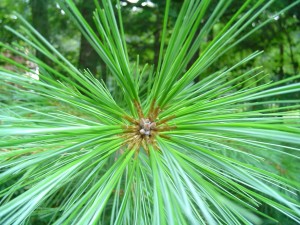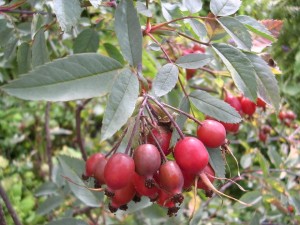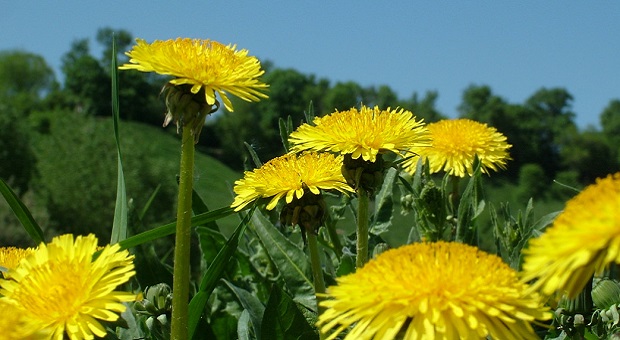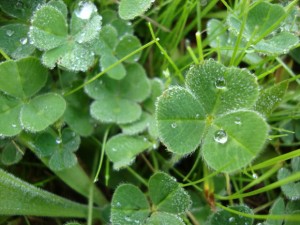Since you never know when you may be caught high and dry in the wilderness with little or nothing in the way of survival gear or emergency food, this article aims to arm you with some extra knowledge about common wild edibles.
We’ll go over 10 of the most common wild edibles, what nutrition they contain and how to prepare them or which part(s) to eat.
1) Dandelions
Renowned as a weed and the bane of many a lawn-owner’s existence, the common dandelion is actually one of the best wild edibles you could ever hope for. Not only does dandelion grow practically everywhere, you also need practically no training to recognize it (especially when it is in flower) and it is absolutely loaded with nutrients.
The nutrients in dandelion include minerals and vitamins such as beta carotene, iron and calcium. Dandelion is also loaded with potassium, biotin, magnesium, phosphorous and zinc, as well as vitamins B1, B2, B5, B6, B12, C, E and vitamin D.
Both the green leaves and the yellow flowers are edible, though most people prefer to just eat the leaves; dandelion greens can be eaten in salads or boiled like spinach or added to soups. They tend to be a more bitter green, so if you want to ease the bitterness try boiling them for a while with 2 – 3 changes of water.
2) Pine Trees

Pine trees might not seem like an obvious source of food, but they are actually a pretty nice, versatile food source. Use pine needles to steep a zesty, refreshing tea that will also replenish your vitamin C levels – pine needle tea had 3 – 5 times as much vitamin C as orange juice. Pine nuts are also edible, highly nutritious and packed with protein; you can eat them raw, roasted, tossed into a salad or ground up into nut butter.
During spring and summer the new, soft green growth of pine needles is edible, too. In a truly tight spot, you can eat the inner bark of a pine tree as well. The inner bark is a good source of sugars and several different vitamins, and you can eat it raw or make it a little more palatable by boiling it. The inner bark can also be dried out and pulverized into flour.
3) Clover
Another plant known more as a weed and a pest in the garden than as a potential food source, you’d be surprised how tasty clover can actually be. White and red clover are both edible, and can be chewed on and eaten raw, tossed in salads, or boiled in soups, stews or a tea. Clover flowers are especially useful for making tea, with a naturally light sweet flavor. Many traditional recipes for hot teas and tonics include clover, as well.
4) Tulips
Okay, so these are often cultivated specifically for their lovely springtime blooms, but many tulips grow wild and they are an edible source of food. Just ask the Dutch who, during WW2, resorted to eating tulips in the face of widespread famine. The edible parts of a tulip include the flower petals, which can be eaten raw, added to salads, boiled in soups or made into tea.
Tulip bulbs are also edible, although the center of the bulb should be removed and they must be cooked very thoroughly before being eaten due to their mild toxicity. Peel tulip bulbs like an onion prior to boiling or cooking; you can also dry the bulbs and pound them into flour. Tulips aren’t the tastiest edible ever, though, especially the bulbs.
5) Black Walnut
Walnuts are one of the easier wild nuts to identify, just look for the giant green ball, sometimes as large as a fist, hanging from the branches or turning gradually brown / black on the ground in autumn. Black walnuts have a rough outer husk that will be green on the tree and then will turn black during autumn as the nuts sit on the ground; beneath the husk you’ll find the inner chamber that you break open to get the nut.
Rich in healthy fats as well as protein, black walnuts also contain magnesium, phosphorous, manganese and copper. The intrepid prepper is in luck with black walnuts, too, because most animals don’t like chewing through the tough, bitter outer husk that protects the nut. That means you can find black walnuts still lying on the ground well into fall and winter.
5) Hazelnuts (Filberts)
Although these are a seasonal wild edible, hazelnuts are a fantastic, bountiful source of food when you can find them. Packed with calories, healthy fats and protein, hazelnuts are also a good source of vitamin E, manganese, thiamine and copper. Look for hazelnuts in the fall when they ripen within their little green husks. Hazelnuts generally grow in dense clusters, and you’ll know they are perfectly ripe when they practically fall out of their green husks.
6) Wild Asparagus
Quite similar to the kind you buy in store, wild asparagus has a much thinner stalk than its domesticated cousin, but it is equally edible and packed with nutrients. Whether you eat it raw or boil it, you can prepare wild asparagus exactly as you would the normal variety and it’s full of vitamin C, potassium, thiamine and vitamin B6.
7) Cattails
While they aren’t the tastiest food ever, cattails provide a surprising source of emergency survival food in a pinch, and they beat eating beetles. Younger cattail is softer and quite edible, but you can also eat the rootstalk of the plant (wash it very thoroughly) either raw or boiled. The leaves can also be boiled and eaten, and you can eat the inner portions of the stalk raw or boiled to soften them. In spring and early summer, when the female spike on the cattail is still young and developing you can break it off and eat it raw like corn on the cob.
8) Rose Hips

While rose hips were once a staple in many folk remedies, and a popular item for making tea, jams and preserves, many people overlook this great wild edible. Sweet and tangy, these juicy red fruits grow in the summer and fall on wild roses after the petals have fallen from the flowers. There are many ways to eat rose hips, including steeped raw, steeped as a tea, in fruit salad and preserved as a jam. You can also make a light, sweet syrup from the juice of rose hips and they are a great source of calcium, vitamin C, vitamin E, vitamin K, vitamin A and manganese.
You can also use rose hips to make what is called rose water. Boil the rose hips in water and then strain the fruit out; when the rose water is cool you can drink it and apply it topically as a tonic. Rose water has natural antiseptic and anti-inflammatory properties, so it’s a great remedy to have on hand and it’s easy to make, too.
9) Raspberries, Blackberries & Boysenberries
For anyone with a sweet tooth and those who love their fruits, you’re in luck because in most areas wild raspberries, blackberries and even boysenberries tend to thrive. You can find these easily identified plants in forests, meadows, along country roads and practically everywhere in between, but be careful not to eat berries from plants treated with herbicides or pesticides.
While it might not need saying, you can collect these berries from mid-summer on through fall. Eat them raw, on cereal, in jams, dry them, bake them in pies or make juice of them, there are tons of things you can do with these sweet, tart berries. They’re also loaded with vitamin C, vitamin K and healthy sugars, so enjoy.
10) Mushrooms
In reality, this should probably be another list in and of itself, since there are many, many types of wild mushrooms that are edible, but mushrooms in general are worthy of note. Whether you eat them raw, sauté them, grill them, boil them, make gravy of them or add them to soup or to eggs, wild mushrooms can add flavor and quite a bit of nutritional content to your meal.
When it comes to identifying mushrooms, however, you must be absolutely certain as there is no room for doubt; many edible mushrooms have poisonous relatives who look very similar and death by mushroom poisoning is a slow and painful process, so be careful. For those who know what they are doing, though, the forest offers a bounty of edible mushrooms, including: oyster mushrooms, chanterelles (an orange, trumpet-shaped mushroom), portabella mushrooms, lobster mushrooms, edible boletus (known more commonly as porcino mushrooms) and many more.
Hopefully you’ve enjoyed this short guide to some of the wild edibles available in a survival situation. Remember to exercise extreme caution whenever you consume wild edibles, and don’t consume a food unless you are absolutely certain of your identification.






































































Pls list characteristics of “friendly” mushrooms and locale of the more common varities located in southern states.
I love your newsletters, but I must say that suggesting fungi, is at least, very irresponsible. People have a very strong chance of dying, and at best, getting really sick. Most fungi should be cooked to avoid taking ill. I have been growing fungi for a couple decades now. I have a good working knowledge of mycology, and I still will not eat anything but a few wild fungi. Every year people that think they know what they are looking for go out to pick, and even then, they will still end up making fatal mistakes. Giant puffballs, and oysters are about the only ones I would trust. A restaurant in NY city a few years back had a chef that would shave fresh morels onto salads. most eating the raw morels took ill. also, many fungi react badly when eaten with alcohol. young amanitas can be mistaken for agarics. Galerinas can be mistaken for many brown mushrooms. both can and have killed entire families that wanted nothing more than to have Sunday pasta with their families. The only sure way to tell one from another is by microscopic exam of the spores.
not really a “strong” chance , I have collected mushrooms since I was child, and have only seen deadly mushrooms twice. I will say No article about eating wild mushrooms should be written without a picture and explanation of how to tell dangerous mushrooms from “good” mushrooms. I also never eat wild fungi raw. The oysters you talk about, (i’m guessing) is what we in the mountains call “chicken of the woods” and are a good substitute for meat when breaded. They could not be confused for dangerous, also the “morel” is unique in appearance and could not be miss typed as well as “inky caps” and many others. I have heard a young death angel could look like an inky cap,but see they wont grow in the same cluster with the inky caps so they are safe. Many many many good mushrooms in the woods to eat. They kept many a southerner from starving to death after the ‘scorched earth ” policy of the north after and during the civil war. But I think he shouldn’t have talked about them without enough space to explain the ways to tell the safe ones apart. These little articles are really too simple and short.
But now that I think of it, we “kill” any deadly mushrooms we find around here and everyone has for years, some peoples woods may have much more deadly mushrooms than ours. So I really cant say they are very rare everywhere, just around these ridges I have grown up around. So I take back what I said, I wouldn’t want anyone to see 5 or 6 mushrooms and think they are good to eat. and die. Your woods may be allot different than mine.
David, Don’t know how you got’ hen of the woods’ outta oyster mushrooms, no resemblance at all, oysters are whiteish rounded shaped mushrooms that grow in clusters on a dead tree, often when found there are upwards of ten to twenty lbs available for harvest at a time. Hen of the woods is a wonderful shroom the for all intents and purpuses looks like a bird [chicken, grouse] sitting on the forest floor, often these will weigh 3 to 10 lbs each and are typicly brown with gray to black tips on a pedaly outer surface with a white solid interior, both are quite edible and good. Sulpher shelves or ‘chicken mushrooms’ are also quite prevalent and easy to identify, a flat cresent shaped shroom that grows on dead trees ,rust colored with bright yellow to cream colored bottom and tastes very similar to chicken breast. There are so many more, but you need a good field guide to identify.
i was wondering where you got your information about dandelion containing vitamin b12. i ask this because b12 is almost unheard of in plants. most sights say you can only obtain b12 in meat. if this is true i will start eating dandelion where i am a vegan.
Robert is on the right track! Death is permanent, and knowing the right mushroom to eat is Very Important!!
Get help from someone who knows, or leave them alone! Guessing which mushrooms to eat without experience is like Russian Roulette! To the average person, I say mushrooms are a last resort.
What a great treat. Thanks for the wonderful article. Everybody should know this and be ready.
dandelion greens are irritating to the bladder.
And starvation is irritable to the brain and stomach. We’re not talking about choosing wild flowers over your local grocery store, we’re talking survival. I suppose it is noteworthy to let folks know about known side effects of these wild edible options though, so thanks for that info Carole
Hmmmm, and I am just finishing up my 3rd semester and our professional herbalist/naturopath/dr. of oriental medicine, etc., etc., etc. SWEARS that dandelion greens are of GREAT USE in treating edema and causing the urinary system to drain. I’m not sure he would consider that “irritating to the bladder”, even though it is true that they do cause the kidneys and UT to cleanse itself and drain. ALSO: FYI, dandelion ROOT is waaaaay up there as a Liver Healer! A great thing to know in a pinch!!
Oops! That first line was SUPPOSED to say “just finishing up my 3rd semester of Botanical Medicine coursework”….! and “they do cause the kidneys and UT to cleanse themselves and drain”. Sorry! I def. need to proofread my comments better from now on!
There isn’t a whole lot of nutritional value in mushrooms. Even people who have a good knowlegde of them have mistaken the “angel of death” for an edible shroom. I will say a giant puffball sure goes good with a nice steak.
but here are a few edibles that I put in salads: violet leaves, lambs quarters, sheep sorrel, wood sorrel (high in oxalic acid, as is clover, so don’t overdo them), any amaranth, such as red root pigweed.
Thanks, Carol! That is a great list of wild edibles. I would also add two more, if you won’t mind: chickweed, which is supposed to help with fat digestion and actually processing (i.e. losing) fat in the body, and garlic mustard plant. I harvested some garlic mustard a few days ago. Fresh it tastes like garlic, for sure, and I am pretty sure it would contain enough alicin to be of benefit. HOWEVER, don’t make my mistake as a beginner and put some leftover leaves in the fridge. I steamed them 2 days later and MAN, they were bitter!!! Both of these wild edibles are very, very easy to find in the springtime. JUST BE CAREFUL, please, to try to find sources for all wild edibles that are far from roads or fields that have had a lot of pesticides/herbicides on them, or they will be filled with toxic residues. Wouldn’t want you to avoid all those poisonous mushrooms and then slowly poison yourself from scrounging close to roads or toxic areas/toxic/dumped-in waterways!! By the way, the blue constituents in purple violet FLOWERS make them a very healthy item to eat, as well as the Vit-C-rich leaves of the violet plant. Some people pick lots and smother in honey for coughs and sore throats. 🙂 Many good-to-great comments & recommendations in this section, guys!! By the way, my friend just introduced me to drinking tea from the Staghorn Sumac (think Vit. C) and to drinking tea of the blossoms of the Red Bud trees that are so beautifully lavender/pink in the springtime. Both were simply wonderful! 🙂
when it comes to mushrooms, learn the id the spore print.
Thank you, Ken Pifer, for the necessary cautions. I’ve spent time in the mountains on extended hikes eating off the land, and never partook of, or even touched, any of the mushrooms I came upon. I’ve studied books about them, and think I can identify those that will kill, but even so, I don’t trust me to try any when there is usually plenty of non-fungi to be found. Afterfhought; you’ve got to be early to beat the bears to wild raspberries and strawberries.
ha-ha-ha!
Thanks. I’m intimately familiar with all that you’ve recommended in your List although, I would tend to agree with those that have commented about fungi/mushrooms… one can’t be too cavalier when mistaken identity could down-grade & change your world in a hurry!
I am hoping at some point to see more survivor information of all types that are also geared for those of us that live in and around the SW Desert. How to survive in a critical emergency situation during the heat of the summer in these parts is especially concerning and of keen interest to me!
I was raised on just about everything mentioned, but the only mushroom I ever ate from the wild is the Moral or as we called it Sponge mushroom. It’s only out for a short time in the spring, the good thing is you can’t mistake a cone shaped sponge coming out if the leaves we always soaked them in salt water to get the bugs out before cooking them. Love them in scrambled eggs.
What about the tubers under the cat tails. I hear they taste a lot like sweet potatoes. I never tried them so I have no idea what they’re like.
Cattail roots are very bland, and you need to either roast or boil them, and then mash the starchy parts out of the fibers before eating them.
The mushroom book I have says not to eat ANY mushroom with a bulbous base, meaning: imagine your hand palm up, fingers forming a bowl and a stalk etc growing out of it. In northern Wisconsin, we had a lot of amanita’s, very beautiful and very poisonus. Get a good picture book of mushroons, pick some and remove the stem, lay the cap on colored and white paper overnight to get a spore print for identification. The only ones I’ve eaten are morels, shaggy manes and puffballs. I froze puffballs, cut into half inch slices. They kept good for about three months.
Dandilion root is edible raw, boiled, roasted as an alternative to coffee.
dried and ground for flower
Cat Tails: Native American’s used the brown head fluff as disposable
diapers. The early spring shoots are good stir fried or in soups. The roots,
especially the connecting root between plants can be pealed rolled in salt
and roasted for a crunchy treat or put in soups or roasted and ground into
flour. The pollen of the fluffy head has been used as a flour for at least
19,000 years in North America.
Blackberries, Raspberries, Salmon berries have wonderful spring shoots.
Native children refer to them as a candy plant. They are usually the first
fresh green eaten in the Spring.
Guest post – by Sandi
There is no reason to starve in country where people have lived for 19,000
years without a grocery store. There are many books with pictures and some
even have recipes of native plant. My favorite is a Plants of the Pacific
Northwest which has photographs to ease identification and tells how Native
Americans used the plant as food, medicine, or for other uses.
Since my Dad took me on my first hunting and fishing trips he has always told me never go to the wild without a knife and lighter or matches. I have been on my own survival trips a week to 10 days at a time, with food supplies for 3 days. I always came back with 3 days of food and sometimes a couple extra pounds. Survival is not just something to know in an emergency, it is sometimes needed on a daily basis. My 9 year old son and I we caught in a very heavy snowstorm just outside of Jefferson City, MO. A real blizzard, 10ft visibility, temp. was about 28 degrees and falling, he said, “Dad I’m really cold.” We were about 1/4 mile from home on foot. I had a Bic lighter and a Buck knife, 45 minutes later and following my instructions we had a shelter, fire and pine tree tea brewing.
He was amazed and said, “Dad where did you learn this stuff?”, my answer to him was, “From my Dad.” Now he is 26 years old with a son of his own, I also have a 14 year old daughter who is very adaptable in the woods anywhere, from making here own fishing pole to fishing with a hand made spear. The woods are a storehouse of supplies for the true survivalists it just takes a little learning. Both of my Grandfathers and my Dad and Stepdad told me the same thing about life, “Ignorance can be cured, stupidity is forever.”
Also a footnote to my earlier comment, the is a survival series of encyclopedias I believe are called the Foxfire Series on Survival I had this set in my college days and I went back home they were “misplaced” by my cousins husband who tried for months to get me to sell them to him, needless to say my answer was always,” NO!” If you can find the series BUY IT, it will tell you how to build traps with vines to catch anything from a rabbit to a deer. If you find them PLEASE LET ME KNOW WHERE TO GET THEM. Thanks to all who still know how to use common sense. The Old Hippie.
I would love to be able to find those Fox Fire Survival Books, if any one knows any thing of them, please let me know. I am an avid out doors person, but never learned of any of the wild edible plans and roots. I did learn that some flowers are edible. Thanks to any one for your help.
5/3/2014 Foxfire books appear regularly on eBay at reasonable prices.
I think this stuff is really cool.
Cannot download this .pdf I get this error code when trying to click it:
TCPDF ERROR: [Image] Unable to get image: http://www.survivopedia.com/wp-content/uploads/2013/05/Tulip-in-Kazakstan-300×225.jpg
Thank you
is the foxfire fungi edible ??
It is not, Jerry
Alex, from Survivopedia.